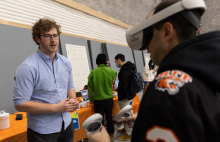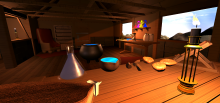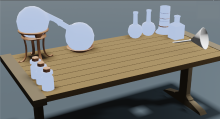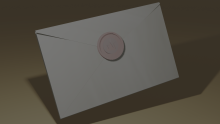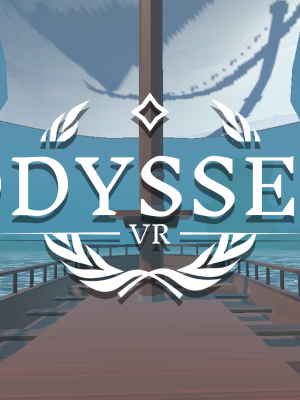A Collaboration between Rossell Hope Robbins Library and Mary Ann Mavrinac Studio X.
Step back in time in this virtual alchemy lab, developed by students in Studio X and the Robbins Library.
About the Project
Turn base metals into gold, fulfill the townsfolk's requests, and unlock the power of the philosopher’s stone in Aurum VR. Featuring authentic 17th-century texts from the Robbins Library’s collection, alchemical history is brought to life in virtual reality through this interdisciplinary collaborative project between Studio X and the Robbins Library. You’ll feel like a true alchemist as you step in the shoes of the alchemist Kiana, creating real ancient recipes, using period-accurate tools, and discovering the secrets of this ancient craft.
Through Aurum, we aim to expand awareness of and access to our library’s diverse collections through transformative methods, encouraging a new way of interacting with texts hands-on.
FAQ
Alchemy has existed across various cultures and regions throughout history. Its goal is to understand the science of natural substances, their changes, and their transformations. While you might be picturing someone turning base metals into gold or creating some kind of healing potion, many alchemical texts are linked to spiritual and philosophical enlightenment.
Western alchemy originated with a close relationship between mysticism and metallurgy in ancient Egypt around 4,000 years ago. Everything we know of Egyptian alchemy is in the writings of ancient Greek philosophers—most of whose writings only survived in Islamic translations.
In China, alchemy was primarily connected to medicine. Alchemy was known as waidan (external alchemy) and neidan (internal alchemy). Waidan was focused on creating elixirs of immortality and using minerals and metals to treat diseases, while neidan was used for spiritual transformation and the cultivation of the inner self.
In India, alchemy was known as rasayāna, which literally means “the path of the juice” or “the path of essence.” Rasayāna was associated with a system of medicine that used mercury as a core element of its operations, compounds, and medicines. Rasayāna aimed to heal people who were too sick to recover and to increase people’s life spans.
In the Islamic world alchemy (ilm al-kimiya) flourished during the Islamic Golden Age. Heavily influenced by Greek and Egyptian alchemy (most of what we know of earlier traditions is through Islamic translations and commentaries), Islamic alchemists were responsible for major discoveries that furthered alchemy and other sciences, including hydrochloric, sulfuric, and nitric acids, potash, soda, and the technique of distillation. They also made significant advancements in the fields of chemistry, pharmacology, and metallurgy.
The alchemy that developed in Europe during the Middle Ages was heavily indebted to the Islamic tradition, through which European alchemists encountered the works of ancient Greek and Egyptian alchemy. Alchemy was deeply tied to religion and philosophy, and many influential alchemists were also priests, monks, or friars. By the end of the Middle Ages, however, alchemy was more associated with occult practices. In the 16th and 17th centuries, alchemy was studied alongside magic, medicine, and what we now think of as modern science, particularly chemistry. Many scientists such as Robert Boyle, Isaac Newton, and Tycho Brahe were also alchemists. While the pursuit of transmutation and the creation of an elixir of life were eventually abandoned, alchemy played a significant role in the development of modern science.
What is the Robbins manuscript?
This manuscript is a personal collection of alchemical texts from 17th-century Italy, containing more than a dozen recipes, many of which involve the creation of the philosopher’s stone.
Our research team has transcribed and translated the texts from the manuscript, which were originally written in both Latin and Italian. These texts include some of the most popular alchemical treatises from the late Middle Ages and early modern periods.
While the original owner of the manuscript remains unknown, it’s highly likely that the owner was an alchemist who gathered materials from their own experiments and their colleagues.
Through Aurum VR, you can step into the shoes of an alchemist and explore the recipes found in the alchemical miscellany manuscript, gradually unraveling the secrets of the ancient craft.
What do you mean by “de-Westernizing” alchemy?
Like many aspects of history, much of the popular understanding of alchemy concerns transmuting metals into gold, chasing eternal life, and the work of Western alchemists such as Isaac Newton and Tycho Brahe. Although these contributions are important, many don’t know that the European alchemical tradition draws strongly from Islamic alchemy, and likely would have died out before the Middle Ages if not for documentation from Islamic scholars.
Additionally, areas such as China and India have extremely rich alchemical traditions to draw from. A smaller but still significant group of Jewish alchemists also made major contributions to the discipline during the Middle Ages. While areas outside of Europe also at times attempted to transmute metals or prolong life, other disciplines also concerned significant spiritual, religious, and medicinal elements. We seek to incorporate these elements within Aurum in equal number to the European tradition.
By including these non-Western aspects and ensuring a holistic representation of alchemy, we “de-Westernize” the discipline by uplifting non-Western aspects of the history that have been long neglected.
Timeline
2021:
- Collaborative planning between Studio X and the Robbins Library to create a shared vision.
- Alchemical miscellany manuscript digitized by Lisa Wright in the Digital Scholarship Digitization Lab.
- Research conducted on alchemical practices and notable alchemical achievements.
2022:
- Worldbuilding activities, such as sketching, creative writing, and discussion.
- Scene created in Unity; locomotion and grabbables implemented.
- Initial 3D models created in Blender and imported into Unity.
- 3D Modeling, Coding, and Story sub-teams established.
- Heating and glass breaking features developed.
2023:
- Selected models animated.
- Liquid simulation implemented.
- First full step-by-step recipe implemented.
- Five recipes from Robbins Library manuscripts translated and formatted.
- Initial user interface and welcome screen implemented in Unity.
- Lab space entirely remodeled to be more historically accurate.
2024:
- Robbins manuscript modeled and animated for use in-game.
- Style guide developed to standardize game appearance.
- Implemented second step-by-step recipe.
- Creation of 5+ characters within the town.
- Addition of UI/UX taskforce; development and implementation of a recipe selection UI system.
Goals
- Reimagine our library’s collections from a more interactive perspective.
- De-Westernize the perception of alchemy and showcase its rich global history and relevance to a contemporary audience.
- Transform teaching and learning. Instead of reading about alchemy and imagining the laboratories, tools, recipes, and experiments, what if you could carry out the experiments yourself within a medieval laboratory setting? How would mixing the ingredients and handling the tools impact your understanding of this history?
- Embrace interdisciplinary collaboration by bringing together history, science, art, and technology.
- Foster hands-on, skill-based, project-based learning opportunities. Students learn XR software and hardware, collaborate in teams, and conduct research in a meaningful way.
Values
- We are committed to showcasing the diverse and global history of alchemical practices and promoting a more inclusive and expansive view of history.
- We strive to make our experience accessible to everyone, regardless of background or ability, and are dedicated to creating a comfortable and enriching environment for all.
- We seek to engage participants in an immersive and interactive learning experience, drawing on the rich resources of the Robbins Library.
- We aim to leverage cutting-edge technology and modern design practices to bring the ancient art of alchemy to life in a new and exciting way.
- We value the contributions of multiple stakeholders, including the Robbins Library and user feedback.
Collaborators
Leadership
- Aleem Griffiths, Sound Design, Section Supervisor, Studio X
- Liz Hogrefe, Project Manager, Karp Library Fellow, Studio X
- Meg Moody, Project Mentor, Assistant Director, Studio X
- Anna Siebach-Larsen, Research Advisor, Director, Rossell Hope Robbins Library
3D Modeling Team
- Josh Jones, Team Lead, XR Specialist, Studio X
- Emily Lin, XR Specialist, Studio X
- Caleb Kohn-Blank, XR Specialist, Studio X
- Gayatri Shetty, XR Specialist, Studio X
Coding Team
- Fenway Powers, Team Lead, XR Specialist, Studio X
- Richard Chuong, XR Specialist, Studio X
- Sherkeem Duprey, XR Specialist, Studio X
Previous Collaborators
- Libby Braun, Modeling Team Lead, XR Specialist
- Tamuda Chimhanda, Modeling Team Lead, XR Specialist
- Ayiana Crabtree, Story Team Lead, XR Specialist
- Muhammed El-Sayed, Project Mentor, Karp Library Fellow
- Samuel Henderson, Coding Team Lead, XR Specialist
- Koshala Mathuranayagam, XR Specialist
- Waleed Nadeem, XR Specialist
- Liam O’Leary, Technical Advisor, XR Developer
- Mila Paymukhina, Project Manager, XR Specialist
- Fin Tran, XR Specialist
- Miles Vilke, Coding Team Lead, XR Specialist
- Noah Viso, Project Manager, XR Specialist
- Haochen Zeng, XR Specialist




